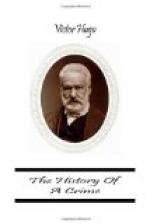“Have you another gun?” asked the last-maker of the taller of the two workmen.
“If we had three guns we should be three men,” answered the workman.
The little one added, “Do you think that the good will is wanting? There are plenty of musicians, but there are no clarionets.”
By the side of the wooden paling could be seen a little, narrow and low door, which looked more like the door of a stall than the door of a shop. The shop to which this door belonged was hermetically sealed. The door seemed to be equally closed. The last-maker went up to it and pushed it gently. It was open.
“Let us go in,” he said.
I went in first, he followed me, and shut the door behind me. We were in a room on the ground floor. At the end, on the left, a half-opened door emitted the reflection of a light. The room was only lighted by this reflection. A counter and a species of stove, painted in black and white, could be dimly distinguished.
A short, half-suffocated, intermittent gurgling could be heard, which seemed to come from an adjoining room on the same side as the light. The last-maker walked quickly to the half-opened door. I crossed the room after him, and we found ourselves in a sort of vast shed, lighted by one candle. We were on the other side of the plank paling. There was only the plank paling between ourselves and the barricade.
This species of shed was the ground floor in course of demolition. Iron columns, painted red, and fixed into stone sockets at short distances apart, supported the joists of the ceiling; facing the street, a huge framework standing erect, and denoting the centre of the surrounding paling, supported the great cross-beam of the first story, that is to say, supported the whole house. In a corner were lying some masons’ tools, a heap of rubbish, and a large double ladder. A few straw-bottomed chairs were scattered here and there. The damp ground served for the flooring. By the side of a table, on which stood a candle in the midst of medicine bottles, an old woman and a young girl of about eight years old—the woman seated, the child squatting before a great basketful of old linen—were making lint. The end of the room, which was lost in the darkness, was carpeted with a litter of straw, on which three mattresses had been thrown. The gurgling noise came from there.
“It is the ambulance,” said the last-maker.
The old woman turned her head, and seeing us, shuddered convulsively, and then, reassured probably by the blouse of the last-maker, she got up and came towards us.
The last-maker whispered a few words in her ear. She answered, “I have seen nobody.”
Then she added, “But what makes me uneasy is that my husband has not yet come back. They have done nothing but fire muskets the whole evening.”
Two men were lying on two of the mattresses at the end of the room. A third mattress was unoccupied and was waiting.




